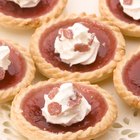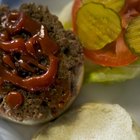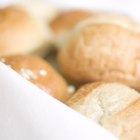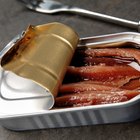
When you're expecting company, a few sheets of puff pastry can be your best friend. You can make up elegant-looking appetizers quickly and easily by taking any savory item you have on hand, and either wrapping it in puff pastry or spooning it into a puff pastry shell. For example, sausages wrapped in puff pastry are an easy finger food. You can make them up in minutes if necessary, or prepare them a day or two ahead.
About Puff Pastry
Generations of frugal European bakers have made quick desserts by rolling a bit of butter and sugar into their leftover bread dough, making it sweet and flaky. Puff pastry refined that technique, wrapping an unleavened dough around a block of kneaded butter. After rolling and folding the dough in a complex series of steps, the baker ends up with a thin dough containing several hundred individual layers of pastry. When it's baked, it puffs to four times its size -- hence the name -- and becomes perfectly crisp and golden.
Preparing the Rolls
You can use any sausage to fill a sausage roll, though for the best balance of pastry to meat they should be no thicker than a standard hot dog. If you're using hot dogs or other fully cooked sausages, they don't need any further preparation. Uncooked sausages should be gently poached in simmering water or broth until they reach an internal temperature of 165 degrees Fahrenheit, then cooled completely in the refrigerator. Cut your sheets of puff pastry to the length of your sausages and 3 to 4 inches wide. Brush one end of the pastry with a beaten egg, then roll the sausage into the pastry. Place the end of the pastry at bottom, and press down gently to seal the edge.
Storage
You can choose to store the sausage rolls either baked or unbaked, whichever is more convenient for you. If they're unbaked, you can refrigerate them covered for a day or two without any noticeable deterioration in their quality. If you want to make them up further ahead, it's best to freeze them. You can take them directly from the freezer to your oven, once your guests arrive. Alternatively, you can bake them ahead of time and simply reheat them for company. They'll keep for three or four days in the refrigerator before losing their freshness, or can be frozen for three to four months. Reheat them gently at 200 F until they're crisp and warmed through.
Food Safety
When preparing any perishable food in advance, it's important to keep food safety in mind. Wash your hands, utensils and work surfaces scrupulously with hot, soapy water before you begin. Use sausages that are well within their freshness date and keep them refrigerated. Take out just a few at a time to make up the rolls and refrigerate the finished rolls as you make them. Use a meat thermometer or instant-read thermometer to ensure that the sausage reaches a food safe internal temperature of 165 F when it's cooked. Perishable foods should never be at room temperature for longer than two hours, so set out your sausage rolls in small batches and discard any that remain uneaten.
Related Articles

Can You Freeze Cornish Pasty?

How to Freeze Sausage Biscuits

Can You Freeze Homemade Calzones?

Can Puff Pastry Appetizers Be Made in ...
How to Make Frozen Breakfast Burritos

Can I Make Doughnuts From Frozen Yeast ...

Can Strudel Be Frozen Before Baking?

Can Crescent Rolls Expire?

How to Make Mini Tart Shells

Can I Make Monkey Bread the Night ...

How to Make Cannolis by Baking

How to Freeze Tortilla Shells

The Best Way to Freeze Sausage Balls

Desserts That Can Be Made With Puff ...

Should I Let Pastry Shells Thaw Before ...

Gherkins vs. Bread and Butter

Can Yeast Bread Dough Be Frozen Before ...

Can I Prepare Baked Brie Ahead of Time?

Can You Freeze Leftover Dough From a ...

How to Store Opened Anchovies
References
- The Professional Pastry Chef; Bo Friberg
- USDA Food Safety and Inspection Service: Sausages and Food Safety
Writer Bio
Fred Decker is a trained chef and prolific freelance writer. In previous careers, he sold insurance and mutual funds, and was a longtime retailer. He was educated at Memorial University of Newfoundland and the Northern Alberta Institute of Technology. His articles have appeared on numerous home and garden sites including GoneOutdoors, TheNest and eHow.
Photo Credits
Michael Blann/Photodisc/Getty Images